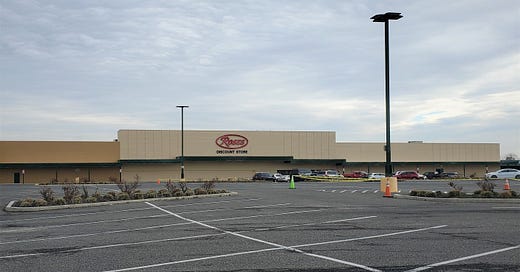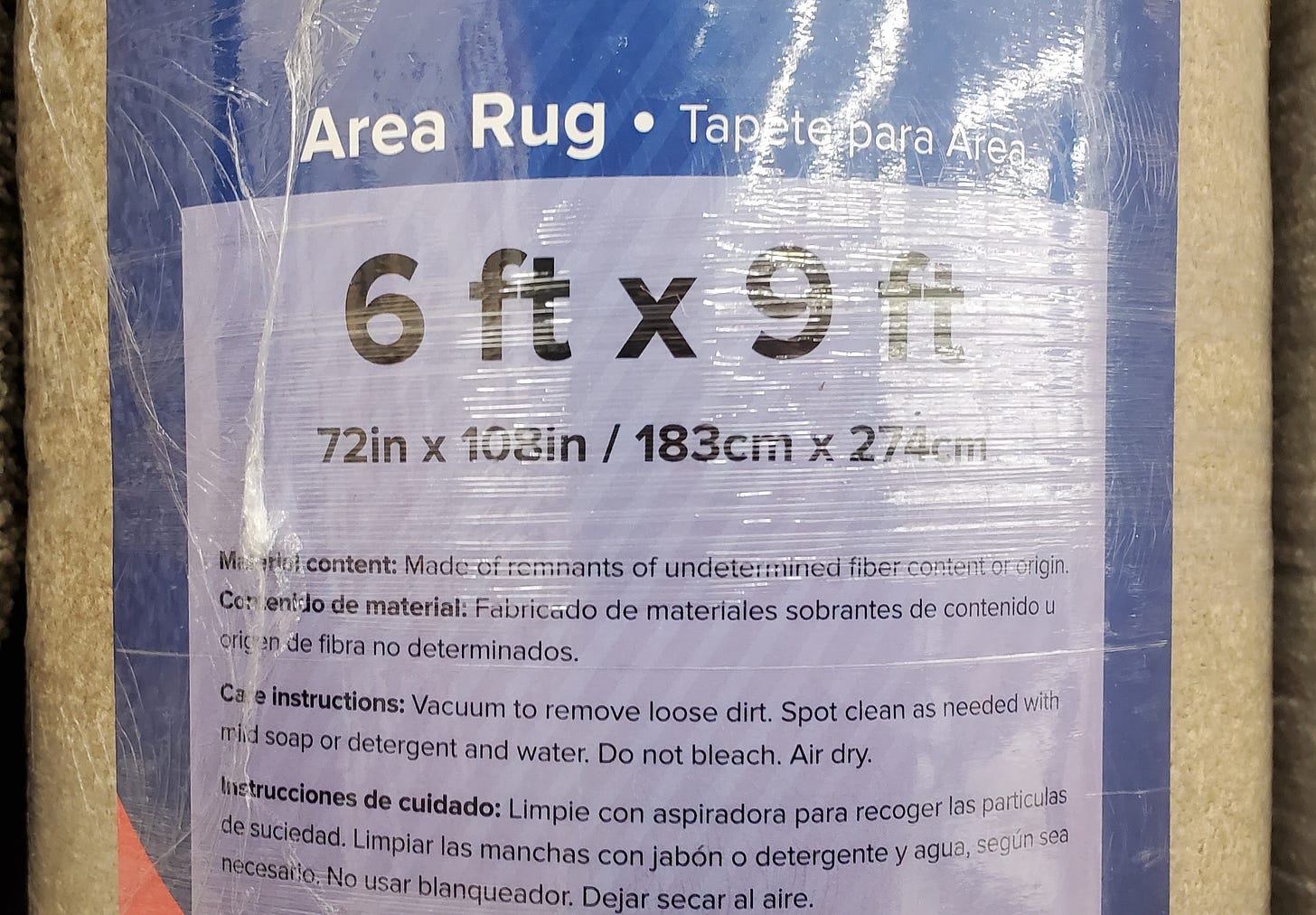Readers: This week marks the two-year anniversary of this newsletter! For just this week, I’m offering an anniversary discount for new yearly subscribers, in case you’ve been on the fence about upgrading to a paid subscription. Your support—whether reading, sharing, or subscribing—keeps this thing going. Here’s to another year of The Deleted Scenes!
A few weeks ago I had a piece in The Bulwark on an interesting regional discount chain called Roses. It’s a real throwback—one of the few chains of its type to survive the expansion of Walmart throughout the 1990s and early 2000s. The closest national chain to Roses is probably K-Mart, with a grand total of three stores left in the United States. Roses has a tad under 200, and operates mostly in the Southeast and Mid-Atlantic (it’s based in North Carolina.)
Some background:
Like many, perhaps most, discount department stores, Roses (formerly styled with a possessive apostrophe between the e and s) can trace its history back to the early twentieth century. It originated as a five-and-dime/variety store, as did many other discount department stores. (Some, like Target, started out at the opposite end of the commercial spectrum, as discount versions of “real” department stores. Dayton’s was the upscale parent company in Target’s specific case—convergent evolution, if you will.)
All of which is to say, if you have any recollection of Ames, Woolworth, Caldor, Bradlees, Zayre, or the nearly extinct Kmart itself, you already know what Roses is like. But it’s notable because, with the (barely lingering) exception of Kmart, all those other stores, and dozens of others like them, are defunct. The period roughly from 1990 to 2005 was an absolute bloodbath for the discount department store world, as Walmart and Target aggressively expanded.
This makes Roses a living fossil: It’s one of the last remaining mid-sized regional discount department store chains in the United States.
I use these evolutionary analogies a lot. One day, I’m going to sit down and draw the discount-retail evolutionary tree.
I mentioned a few of the interesting things I saw for sale at the nearby Roses I checked out (southeast of Washington, D.C., in Prince George’s County, Maryland):
Cheap electric space heaters with a tiny “refurbished” sticker on the box (probably a batch of returns or some such). Thick, soft area rugs made of undetermined carpet remnants that have been professionally trimmed and finished. (Every single area rug I’ve seen in every other store is a thin imitation of real carpet.) Target-brand dish towels (with the labels cut in half) for a buck. Big packages of cotton rags for pennies a piece (from a manufacturer called St. Mary’s, which has more presence on eBay than anywhere else online).
A certain idiosyncratic quality to the offerings, a few genuine deals, a sense that some of this stuff is a bit older-fashioned than the offerings of the bigger chains—it all makes me wonder if this is what we lost. Is this what box stores were like before Walmart changed the game from regional to national, from a balance of quality and value to pure price, from real and quirky variety to the false variety of hundreds of categories of products but with just one or two options for each?
What these and other products suggested to me was that Roses had some real “product knowledge,” and was pulling its inventory from different channels than the big national discount retailers. Channels that were more regional, more old-fashioned, more idiosyncratic. Channels that simply never stopped existing, but which are no longer actually being opened up.
So you might wonder what this store looks like. Here’s the exterior.
Most Roses stores are in somewhat remote or somewhat poorer areas. K-Mart was sort of like that, but Roses reminds me particularly of Ames, if you remember them. Their mid-sized discount stores were scattered all over rural and small-town New England. (In addition to Walmart, overexpansion killed them.)
The lawn and garden displays outside the store—there is no garden/outdoor department here, which is a space- and cost-saving measure—offered great bargains on a few tools. Cheaper than Home Depot for the same lightweight versions. Plastic lawn chairs for $10.99 too. Not bad.
There’s also no real electronics department. So this is not fully comparable to Walmart or K-Mart. However, some of the now-defunct discount department stores also lacked certain departments. So while there are elements of the closeout store or variety store here, I think Roses qualifies as a “true” discount department store.
Of all the things I saw, I want to show you this area rug first, which I found in a pretty decent selection of area rugs in different sizes:
My wife and I have been looking for an area rug for our new house. Every single place we’ve looked—Home Depot, Lowe’s, Home Goods, At Home (the latter two even recommended by a carpet store employee)—has had the same selection of thin, cheap, basically not-very-nice rugs. I’ve been looking for a rug that’s actually made out of carpet, with the edges professionally finished. But that’s very expensive—the carpet store that pointed me to At Home told me I’d pay about $400 for an 8x10.
So we’ve just put buying the rug on hold. But I think we’re going to go buy one at Roses, because that’s what that rug in the photo is! It’s a properly finished carpet remnant. You can see how thick it is from the photo. Take a look at the label on one of these:
A few more deals. Bath rugs for $3.99.
That’s what I paid for my little bath rug when I started grad school, at a Big Lots. (It was well-made enough; we still have it!) My wife and I were looking recently for bath rugs at Walmart and Target. The cheapest we could find was around $10, and a lot of them were pretty large. We wanted a couple of small, cheap ones just like this. It isn’t just the price; it’s the product itself. And beyond this endcap, there was half an aisle of bath rugs.
Some other neat finds and good deals:
A surprisingly large fan selection:
Some decent selections of items you won’t find in dollar stores and smaller discount stores, and at good prices:
And a larger view of the old-school interior:
There’s something neat and very difficult to pinpoint about a lot of this merchandise. It’s inexpensive and cheaply made, yes. But it doesn’t feel as though it’s been put through a corporate wringer designed to shave down every possible cost to its limit.
I pay a lot of attention to the stuff on store shelves, because I’m picky about buying things. And so much stuff for sale in big chains just has this flimsy feel. Something about Roses’ merchandise triggers vague memories of when stuff for sale was better.
I speculate why this might be:
In some ways, Walmart is constrained and limited by its business model and ubiquity. There are over 4,000 Walmart stores in America, and they all need to stock more or less the same things. That limits them to suppliers who can 1) offer rock-bottom prices, and 2) supply amounts sufficient to fill shelves and displays in thousands of stores.
The idea being, the concentration of retail and the sameness and junkiness of the merchandise are one in the same.
Here are a couple of links from around the web where you can see and read more about Roses.
As is sometimes the case with these kinds of pieces, I got some pushback. One, that Roses isn’t a discount department store but a glorified dollar store preying on distressed communities. And two, that Art Pope, the president of its parent company Variety Wholesales, is a sort of anti-worker robber baron type.
On the second count, it might be true. Pope is a big donor to right-wing causes, some of which are kind of bad and others of which are more arguable. He doesn’t seem great—not a civic-minded person who sees his business as a form of service. Then again, neither are most CEOs. Neither are Walmart or Amazon.
On the first count—that Roses is just another junk store—I can only say that what I saw contradicts that. It lacks the bright, clean aesthetic of, say, a Target. But the actual stuff, and the actual prices, gave me an impression of quality and value.
The thing about calling these stores predatory is that these rural communities and small towns have already largely been hollowed out.
Dollar stores do seem to be problematic—here’s a good piece probing that question. But as I note in the original piece, a mid-sized, mid-scaled big-box chain is fundamentally a different animal than Walmart or Target. It can work with smaller suppliers, which supports a separate supply chain and manufacturing base. It can locate more flexibly because it has a smaller trade area. Smaller store size and chain size/reach bend the fundamentals of the business in what I think is a good direction.
I’ll leave you with the same conclusion as the original piece:
Nobody really mourns this or even thinks about it; when ruminating on this general theme, we usually think about the hollowed-out Main Streets and shuttered mom-and-pop establishments. But the regional discount department store chain that operated 50 or 100 or 200 stores, at 40,000-70,000 square feet each, in two or three or four states, in rural or small-town settings—when we lost those, we lost something important, too.
Thanks for following along, and read the whole Bulwark piece too.
Find all of my Roses photos here!
Related Reading:
Walmart, Sam’s Club, and...Bud’s?
Thank you for reading! Please consider upgrading to a paid subscription to help support this newsletter, discounted just this week! You’ll get a weekly subscribers-only post, plus full access to the archive: over 600 posts and growing. And you’ll help ensure more material like this!














